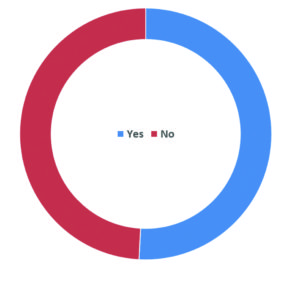This year, there were eight TechBeat surveys conducted primarily among the readership of TechPro magazine.
The topics covered were GDPR and security, cloud computing, general security, digital transformation, work spaces, work styles and data interconnects.
The largest sample size was 175, the lowest was 103, with an average of 133.625.
Across the broad range of topics, some very interesting insights emerged, and I would like to take this opportunity to thanks each and very respondent, without whom we could not run the series at all. The lead graphic for this piece characterising the overall trends being seen.
“Those who felt their organisation was fully embracing digital transformation just edged those who did not, with 51 to 49%”
The GDPR and security survey of the April issue, though quite a while ago now, told us that nearly half (49%) respondents thought their directors were aware of the extent of fines under the regulation, and just less (46%) were confident that they had the in-house resources to achieve compliance.
Perhaps surprisingly, the same proportions (15%) thought they were already fully compliant as admitted having made no preparations at all. A good 40% were not compliant but well on the way, but 13% admitted never having heard of the regulation before.
This survey also dealt with the scourge of ransomware, and nearly half (47%) of respondents said that even in the vent of a data breach leading to a ransomware demand, they would not pay a ransom.
Cloud providers
In May, we discovered the criteria for choosing a cloud service provider were tied between reliability, cost and security, all well above speed, accessibility and location.
However, the vast majority (85%) are using cloud services, with almost half (43%) using hybrid cloud solutions, over public primarily (21%) or private (23%). Of those users, the greatest benefits are ranked, respectively as disaster recovery, scalability and then cost and speed of deployment tied. More than half though they would increase their usage of cloud in the next 12 months.
An interesting survey in June looked at IT asset disposal. In the context of GDPR, it was revealing that 27% of organisations admitted decommissioned desktops and laptops can sit around for 6-12 months before being disposed, while some, though a small number, admitted it could be 3-5 years.
Reassuringly, more than half (52%) did use a third party specialist for asset disposal, but 40% of those who use a third party do not audit their processes.
Ransomware
In July, it was established that more than three quarters (76%) of organisations had never been held to ransom by hackers, but 19% said they had. More than half (57%) were confident that their organisations are able to defend against emerging threats, but more than a third (34%) felt that security concerns were limiting adoption of cloud technologies.
However, by this time, GDPR ignorance has fallen to just 3%. That said, there was still 14% of respondents who said that they had not yet done anything about compliance. The rest, some 84%, have taken significant steps toward compliance.
Perceived risks for security over the next 12 months, more than three quarters (77%) said that careless or unaware employees were the greatest risk, followed by outdated information security controls and architectures (46%) and social media use (28%).
Digital transformation has been one of the key issues over the last year, and will continue to be for the next year, as organisations realise the transformation journey has benefits across the board.
Nearly half (43%) of organisations said that digital transformation had boosted profits, compared to 26% who said it had not. Nearly a third (29%) said that they had not yet embarked on a digital transformation effort.
Digital transformation
In terms of the goals of digital transformation, when asked for a top three, the slim lead was taken by improved business processes (68%) over improved customer experience/satisfaction (65%), though both were some way ahead of improved employee productivity (46%) and increased revenue (43%).
However, when it comes to inhibitors, a range was chosen, but in the lead was financial concerns/limitations (55%), with lack of knowledge/skills (52%) and company culture (48%) following closely. Security concerns was strong too at (39%), but the lack of the right technology was significant at 32%.
In a somewhat forward looking question on expected technologies by 2022, drone deliveries, intelligent workplace robots, driverless cars and touch sense prosthetics were all strongly anticipated, but alas, space tourism is not (3%).
In October we found the majority (69%) of Irish organisations still use a distributed model to deliver employee workspaces, with a centralised model along the lines of Citrix, Microsoft RDS and VMware View, accounting for more than a quarter(26%). So that is the majority of organisations till putting a machine on a desk for employees.
When choosing a centralised delivery model, user experience is the primary consideration, followed closely by compliance. But security and availability were a close, but trailing third and fourth. Challenges for implementing and operating workspaces are security, user expectations and budget, but followed very closely by skills, digital transformation and mobility.
Work styles
Workstyles, too, were a subject of inquiry, and 85% of respondents said that the myriad of storage options, across cloud, devices, and official storage sites has made document management harder. Encouragingly, eight out of 10 said that workers could remain productive during the Storm Ophelia weather event, and for those that could not, the main reason was lack of power, not facilities.
In terms of the benefits of mobile working, flexibility was top, with increased productivity following closely. Almost tied some way back then, were attracting and retaining talent, enhanced business continuity, and improved customer service. In terms of inhibitors of mobile work styles, technical issues were top, followed by organisational and cultural issues, and lack of support from senior management.
There was an interesting response to the question on whether organisations were fully embracing digital transformation. Those who felt their organisation was fully embracing digital transformation just edged those who did not, with 51 to 49%, which is the featured graphic on this page.
I chose that as it represents a turning tide that I think shows that Irish organisations are embracing cloud, taking necessary security steps and facilitating workers in flexibility an access. All of this adds up to a fairly optimistic picture of organisations coming round to the benefits of digital business, properly secured, and letting people work like people, not 19th century clerks.
Organisations realise that GDPR cannot be ignored, but like security implementations, transformation and mobile working, efforts need to be supported at board level to truly deliver their benefits.
While we are often described as lagging behind the UK and the US by [insert a time period], there is often a benefit to this in gaining some perspective and wisdom from seeing how others have handled change. Progression and pragmatism, I say, is a good combination.









Subscribers 0
Fans 0
Followers 0
Followers